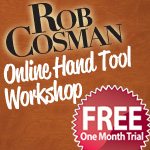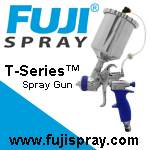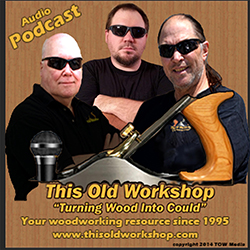What If: Shop Accidents
A look at what to do in case of a shop-related accident
Despite all of the safety gear and equipment that comes with our shop tools and our own good intentions, shop accidents do occur. The Center for Disease Control and the National Center For Injury Prevention and Control both list unintentional injuries as the highest cause of death in both the 15-24 year age group and the second leading cause of death in the 35-44 year age group. Not all of these accidents are shop-related, of course, but serious injury is an important aspect of woodworking and is worth mentioning. It is common to find articles about shop safety and how to prevent accidents, but information on what to do when an injury does occur is a little less prevalent. With the aid of Dr. Geoffrey Stroh, (a board-certified emergency physician at University Medical Center and Attending in the UCSF-Fresno Emergency Medicine Residency Program), This Old Workshop takes a look at some common workshop injuries and what we can do to help ourselves and others when they occur.
Cuts/Amputations
How: Cuts are probably the most common injury received in the shop and usually require only cleansing and bandaging, or in some cases, stitches. Sharp blades and the improper use of safety guards can lead to these accidents. In the most extreme events, amputations may occur.
Treatment: Dr. Stroh's recommendation for an accidental amputation has two parts. The first is the care of the amputated part.
- Gently brush or rinse off any obvious debris. Do not scrub.
- Wrap the part in dry, sterile gauze, or cloth if gauze isn't available
- Place the part in an airtight bag (i.e. Ziploc) and then place bag in an
ice bath.
The goal is to keep the amputated part clean, dry and cool to maximize
chances of replantation.
The second step in emergency care for amputations is the bleeding site.
- If possible, rinse the site under the faucet.
- Wrap with sterile gauze, or clean cloth.
- Apply direct pressure to control the bleeding.
*Note- Unless blood loss is life-threatening, tourniquets are generally not indicated and may actually decrease the chances of successful replantation.
Avoidance: The proper use of all safety guards is important. Also, avoid long sleeves
or any other clothing that may dangle down near the saw blade.
Fire/Burns
How: The use of flammable materials like paint thinner and finish chemicals can lead to
fires in the shop. Also, faulty wiring or overloaded electrical cords can also be a
fire hazard.
Treatment: If a burn has occurred, it is important to first get away from the source and into fresh air. There are three other main considerations for burn injury:
- Inhalation injury (lungs and airway)- Note any trouble breathing,
swallowing or changes in voice. If any of these are present, call 911
immediately. Make sure the victim is comfortable with as much air as
possible. - Related trauma- This is frequent with burn injuries. Use caution when
moving the victim if they have had a fall, as there might be fractures or
internal injuries as well. - The burn itself- Burns should be covered with a cool, moist, clean cloth if it is a small area (i.e. face, arm). Large burns that involve multiple extremities or the torso are best treated with a dry, clean cover, as hypothermia is a significant risk if the victim is wet. Chemical burns should be washed with large amounts of water to flush away as much of the chemical as possible, followed by the treatment as stated above. Exceptions to this are metallic sodium and lithium, which will react with water.
* Note: Do not put anything else on the burn (i.e. cream, ointment). If your community has a burn center, victims with large burns or burns involving hands, feet, face or genitals, as well as children with burns, should be transported to that facility.
Avoidance: Do not use flammable materials near flame and make sure they are stored in the proper containers. Check wires and cords and promptly repair any that are frayed or otherwise damaged. Do not overload outlets. Also, make sure the shop is equipped with a working fire extinguisher and phone.
Inhalation/Ingestion of Foreign Materials
How: Fumes from finishing materials can be inhaled if the work area is not properly
ventilated. Toxic liquids and foreign materials can be inadvertently ingested.
Treatment:
- Inhalation will generally produce headache and/or trouble breathing as the first symptom. Should either of these occur, leave the area and get into fresh area immediately.
- Accidental ingestion of most liquids used in workshops will be of small
quantity. Contact your local poison control center for recommendations on
how to treat the specific chemical involved. Do not induce vomiting of any
hydrocarbon (i.e. thinner, gasoline).These products can be inadvertently inhaled
during vomiting and can cause more problems than if allowed to pass through the intestinal tract.
Avoidance: The proper use of a safety mask over the nose and mouth when working
with chemicals, like paint thinner, can reduce the risk of inhalation. Proper storage in a clearly marked container can help avoid ingestion.
Eye/Ear Injuries
How: Eye injuries can occur when safety glasses are not used. Specks of wood and other materials can get into the eye. Also, chemicals can splash into unprotected eyes. Cuts and blunt injury can occur if there is splintering of wood.
Ear injuries usually happen due to loud machines causing hearing loss. They can
also be hit with projectiles. Also, dust particles can spread staphylococcal
organisms that can lead to hearing loss.
Treatment:
- Foreign material in the eye is one of the most common shop injuries. Usually
these result in an abrasion of the cornea and need evaluation in an emergency
department, first for removal of any remaining material, and second, for pain
control and the prescription of antibiotics. - Should an impaled object occur in one eye, it should be covered without
bumping the object (i.e. nail). Usually a paper cup taped in place will work.
The other eye should also be covered, if possible, as the eyes move in
tandem and looking around may increase the injury. - Cuts and foreign material in the ear generally require emergency department
evaluation. Many an eardrum has been perforated trying to remove things at
home. The cartilage of the ear is also very close to the surface and
specialized treatment is often warranted. Hearing loss may or may not be
permanent, but preventative hearing protection is the key to minimizing
further damage. - Avoidance: The best way to avoid these types of injuries is to wear the appropriate eye and ear safety equipment.
Falls
How: The leading cause of injury in the 65+ age group, falls happen in a number
of ways, mostly involving overextending oneself on a ladder. The usual injuries
that occur with this type of accident is head/neck trauma and limb injuries.
Treatment:
- Head and neck- Anyone who has lost consciousness and is behaving abnormally or complaining of numbness, weakness, tingling, or neck pain should be kept lying still and prevented from moving their neck. Call 911 for any of these complaints.
- Extremities- If there is an obvious deformity or suspected fracture, the
extremity should be immobilized (held in position with whatever is available). Folded cardboard and tape will work. If you can access 911, let EMS do this, as they are trained in splinting techniques. Simply minimize movement until they arrive. - Internal injuries- Falls can often result in internal injuries that may present in a subtle fashion. Vague abdominal pain or feeling light-headed may be indications of an internal injury. The safest option is to call 911 and get the victim to the emergency room.
Avoidance: Read the instructions on the proper use of ladders and step stools. Make
sure the ladder is on a solid surface before ascending. Do not reach out beyond a safe distance while on a ladder. Also, make sure all electrical cords and other equipment are stored safely to avoid tripping.
Electric Shock
How: Allowing electrical equipment near water or cutting cords with power saws can
lead to electric shock.
Treatment: Electrical shock results in two main types of injury.
- Burn to the tissue- The burns that result from the entrance and exit of the electricity may be much more severe than they appear externally. Current is carried along blood vessels, nerves, and muscle tissue and all can be damaged. All but the most minor injuries should be evaluated by a physician. Household current is generally safe for adults, but can be dangerous for those with heart conditions and children.
- AC and DC current can result in stoppage or abnormal rhythms of the heart. Should you witness such an event, make sure it is safe to touch the victim (i.e. power off), then provide rescue breathing and call 911. Operators will instruct you, if needed, in proper rescue breathing technique and get help on the way.
Avoidance: Do not use power equipment near water sources. Be extremely careful when using all power tools.
Many accidents can be avoided with the use of proper safety equipment and caution. When an accident does occur, always have a phone handy in the shop in case a 911 emergency call needs to be made. Local hospitals and ambulance services have inexpensive classes on first aid and CPR. These classes can help you save yourself and others in case of a serious emergency. Be safe while working in the shop!
Sandra Bamber-Granum with Dr. Geoffrey Stroh
In no event shall Dr. Stroh and This Old Workshop.com, its licensors, its suppliers, or any third parties mentioned on the Dr. Stroh and This Old Workshop.COM site be liable for any damages (including, without limitation, incidental and consequential damages, personal injury/wrongful death, lost profits, or damages resulting from lost data or business interruption) resulting from the use or inability to use the Dr. Stroh and This Old Workshop.com Site or the Content, whether based on warranty, contract, tort, or any other legal theory, and whether or not Dr. Stroh and This Old Workshop.com is advised of the possibility of such damages. Dr. Stroh and This Old Workshop.com shall be liable only to the extent of actual damages incurred by you, not to exceed U.S.$1.00. Dr. Stroh and This Old Workshop.com is not liable for any personal injury, including death, caused by your use or misuse of the Site, Content, or Public Area (as defined below). Any claims arising in connection with your use of the Site, any Content, or the Public Areas must be brought within one (1) year of the date of the event giving rise to such action occurred. Remedies under these Terms and Conditions are exclusive and are limited to those expressly provided for in these Terms and Conditions.


















